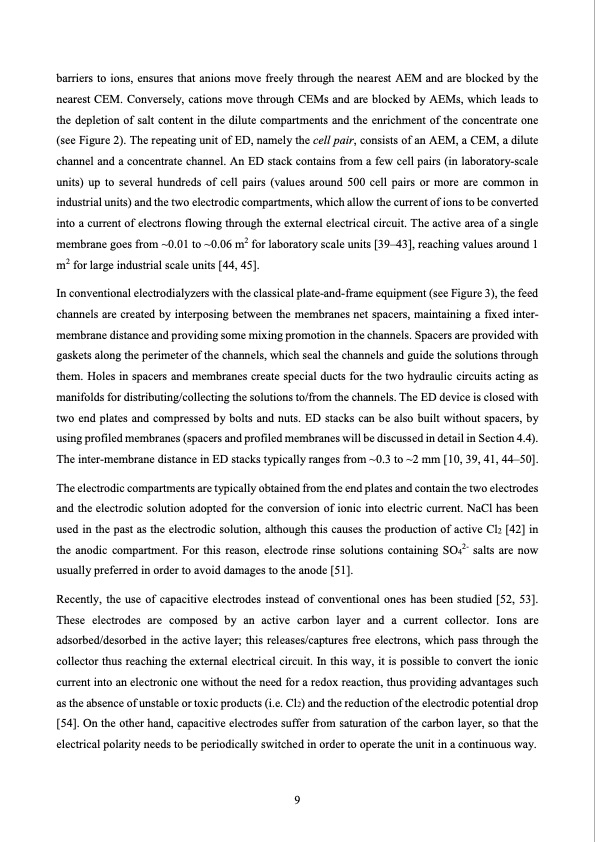
PDF Publication Title:
Text from PDF Page: 009
barriers to ions, ensures that anions move freely through the nearest AEM and are blocked by the nearest CEM. Conversely, cations move through CEMs and are blocked by AEMs, which leads to the depletion of salt content in the dilute compartments and the enrichment of the concentrate one (see Figure 2). The repeating unit of ED, namely the cell pair, consists of an AEM, a CEM, a dilute channel and a concentrate channel. An ED stack contains from a few cell pairs (in laboratory-scale units) up to several hundreds of cell pairs (values around 500 cell pairs or more are common in industrial units) and the two electrodic compartments, which allow the current of ions to be converted into a current of electrons flowing through the external electrical circuit. The active area of a single membrane goes from ~0.01 to ~0.06 m2 for laboratory scale units [39–43], reaching values around 1 m2 for large industrial scale units [44, 45]. In conventional electrodialyzers with the classical plate-and-frame equipment (see Figure 3), the feed channels are created by interposing between the membranes net spacers, maintaining a fixed inter- membrane distance and providing some mixing promotion in the channels. Spacers are provided with gaskets along the perimeter of the channels, which seal the channels and guide the solutions through them. Holes in spacers and membranes create special ducts for the two hydraulic circuits acting as manifolds for distributing/collecting the solutions to/from the channels. The ED device is closed with two end plates and compressed by bolts and nuts. ED stacks can be also built without spacers, by using profiled membranes (spacers and profiled membranes will be discussed in detail in Section 4.4). The inter-membrane distance in ED stacks typically ranges from ~0.3 to ~2 mm [10, 39, 41, 44–50]. The electrodic compartments are typically obtained from the end plates and contain the two electrodes and the electrodic solution adopted for the conversion of ionic into electric current. NaCl has been used in the past as the electrodic solution, although this causes the production of active Cl2 [42] in the anodic compartment. For this reason, electrode rinse solutions containing SO42- salts are now usually preferred in order to avoid damages to the anode [51]. Recently, the use of capacitive electrodes instead of conventional ones has been studied [52, 53]. These electrodes are composed by an active carbon layer and a current collector. Ions are adsorbed/desorbed in the active layer; this releases/captures free electrons, which pass through the collector thus reaching the external electrical circuit. In this way, it is possible to convert the ionic current into an electronic one without the need for a redox reaction, thus providing advantages such as the absence of unstable or toxic products (i.e. Cl2) and the reduction of the electrodic potential drop [54]. On the other hand, capacitive electrodes suffer from saturation of the carbon layer, so that the electrical polarity needs to be periodically switched in order to operate the unit in a continuous way. 9PDF Image | Electrodialysis for water desalination

PDF Search Title:
Electrodialysis for water desalinationOriginal File Name Searched:
Review_ED-self-archived.pdfDIY PDF Search: Google It | Yahoo | Bing
NFT (Non Fungible Token): Buy our tech, design, development or system NFT and become part of our tech NFT network... More Info
IT XR Project Redstone NFT Available for Sale: NFT for high tech turbine design with one part 3D printed counter-rotating energy turbine. Be part of the future with this NFT. Can be bought and sold but only one design NFT exists. Royalties go to the developer (Infinity) to keep enhancing design and applications... More Info
Infinity Turbine IT XR Project Redstone Design: NFT for sale... NFT for high tech turbine design with one part 3D printed counter-rotating energy turbine. Includes all rights to this turbine design, including license for Fluid Handling Block I and II for the turbine assembly and housing. The NFT includes the blueprints (cad/cam), revenue streams, and all future development of the IT XR Project Redstone... More Info
Infinity Turbine ROT Radial Outflow Turbine 24 Design and Worldwide Rights: NFT for sale... NFT for the ROT 24 energy turbine. Be part of the future with this NFT. This design can be bought and sold but only one design NFT exists. You may manufacture the unit, or get the revenues from its sale from Infinity Turbine. Royalties go to the developer (Infinity) to keep enhancing design and applications... More Info
Infinity Supercritical CO2 10 Liter Extractor Design and Worldwide Rights: The Infinity Supercritical 10L CO2 extractor is for botanical oil extraction, which is rich in terpenes and can produce shelf ready full spectrum oil. With over 5 years of development, this industry leader mature extractor machine has been sold since 2015 and is part of many profitable businesses. The process can also be used for electrowinning, e-waste recycling, and lithium battery recycling, gold mining electronic wastes, precious metals. CO2 can also be used in a reverse fuel cell with nafion to make a gas-to-liquids fuel, such as methanol, ethanol and butanol or ethylene. Supercritical CO2 has also been used for treating nafion to make it more effective catalyst. This NFT is for the purchase of worldwide rights which includes the design. More Info
NFT (Non Fungible Token): Buy our tech, design, development or system NFT and become part of our tech NFT network... More Info
Infinity Turbine Products: Special for this month, any plans are $10,000 for complete Cad/Cam blueprints. License is for one build. Try before you buy a production license. May pay by Bitcoin or other Crypto. Products Page... More Info
| CONTACT TEL: 608-238-6001 Email: greg@infinityturbine.com | RSS | AMP |